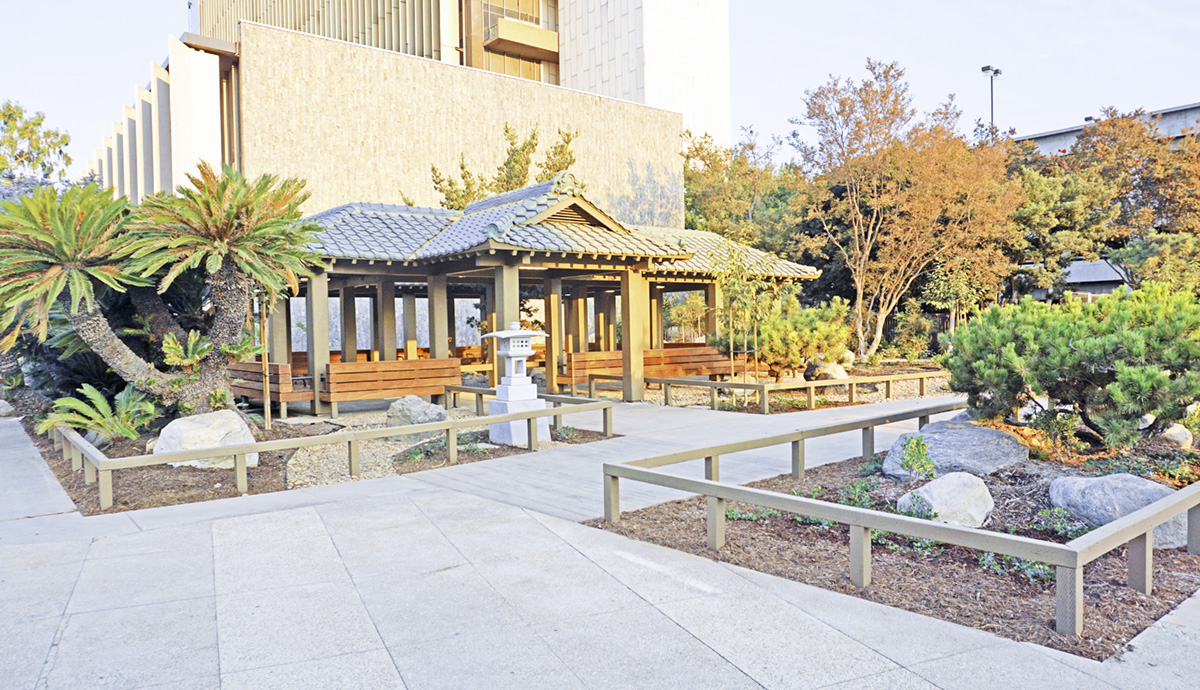The Orange County Japanese Garden went through a major renovation this year in commemoration of its 50th anniversary. A new white stone Japanese lantern sits at the entrance of the tea house, which was a gift from the Orange County Nikkei Coordinating Council. (Photo: Patti Hirahara)
The Orange County Japanese Garden undergoes a renovation as it celebrates its 50th anniversary.
By Patti Hirahara, Contributor
Orange County has had many wonderful things happen in its Japanese community over the years, but none as special as a gift that was given from its Japanese American community to the County of Orange 50 years ago in 1970.
The groundwork was set 29 years before when officers from the Orange County JACL chapter went to the Santa Ana Register newspaper office due to their dismay of the bombing of Pearl Harbor by Japan on Dec. 7, 1941.
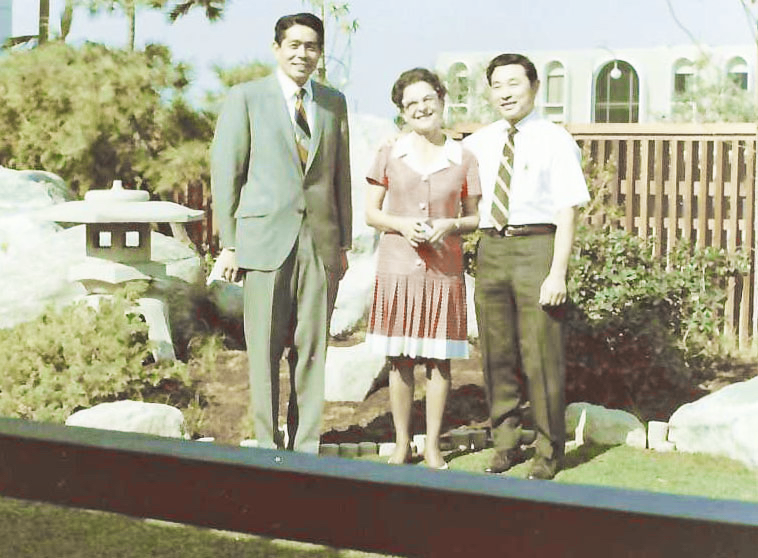
Three of the principals who were part of the Orange County Japanese Garden’s dedication on Nov. 15, 1970, were (from left) Min Inadomi, project legal co-counsel and dedication master of ceremonies; Christine Galanis, County of Orange information services coordinator; and Mas Uyesugi, fundraising chairman at the Orange County Civic Center. The event marked the culmination of three years of planning, hard work and fundraising between Civic Center officials and the Orange County Japanese community. (Photo: Courtesy of Hitoshi and Diane Nitta)
With a photo and story published in the Register on Dec. 11, 1941, four days after the attack, the JACL chapter members declared “their wish of tolerance and understanding on the part of all Americans toward American-born Japanese and other Japanese who obey the laws of this country and expect to call this country theirs for the rest of their life.” The photo cutline also said, “All are native sons of Orange County; all attended school here.”
When asked about their parent’s attitudes, the group said “their parents were born in Japan, but they have been in the United States longer than they were in Japan, and this is home to them and they expect to make it their home until they die.”
For one member of the group, Santa Ana native Hitoshi Nitta, who was 24 years old and treasurer of the OC JACL chapter at the time, this meeting would set the stage for greater things to come.
Even with local JACL members’ valiant effort to prove their allegiance to the country of their birth and the place they called home, 120,000 men, women and children from the western United States were forcibly sent to Japanese American incarceration camps during World War II.
The people from Orange County were primarily sent to the camp in Poston, Ariz., from 1942-45. When discussions of resettlement were brought up in Poston upon the conclusion of WWII, the Nitta family made history for their resettlement back to Orange County.
As noted in a United Press wire story, which was published in the Pasadena Star News on Jan. 8, 1945, “Shosuke Nitta, patriarch of the first Japanese American family to return to Southern California, today shuffled about his 100-acre ranch here after a two-and-a-half-year exile, happy over a heart-warming welcome home by worshippers at the Methodist Church in which he was active for years.” The day before “after services, churchgoers crowded around to shake their hands.”
The article continued, “It was a happy moment for the three generations of Japanese Americans, who had so feared prejudice against them, they stopped for food only once on the car trip from Poston to Santa Ana and that at the home of a Methodist minister in Indio, Calif. “We didn’t want to cause trouble,” Nitta said.
For his efforts nine years later, Nitta was honored in 1966 by Emperor Hirohito for helping to improve relations between Japan and the U.S.
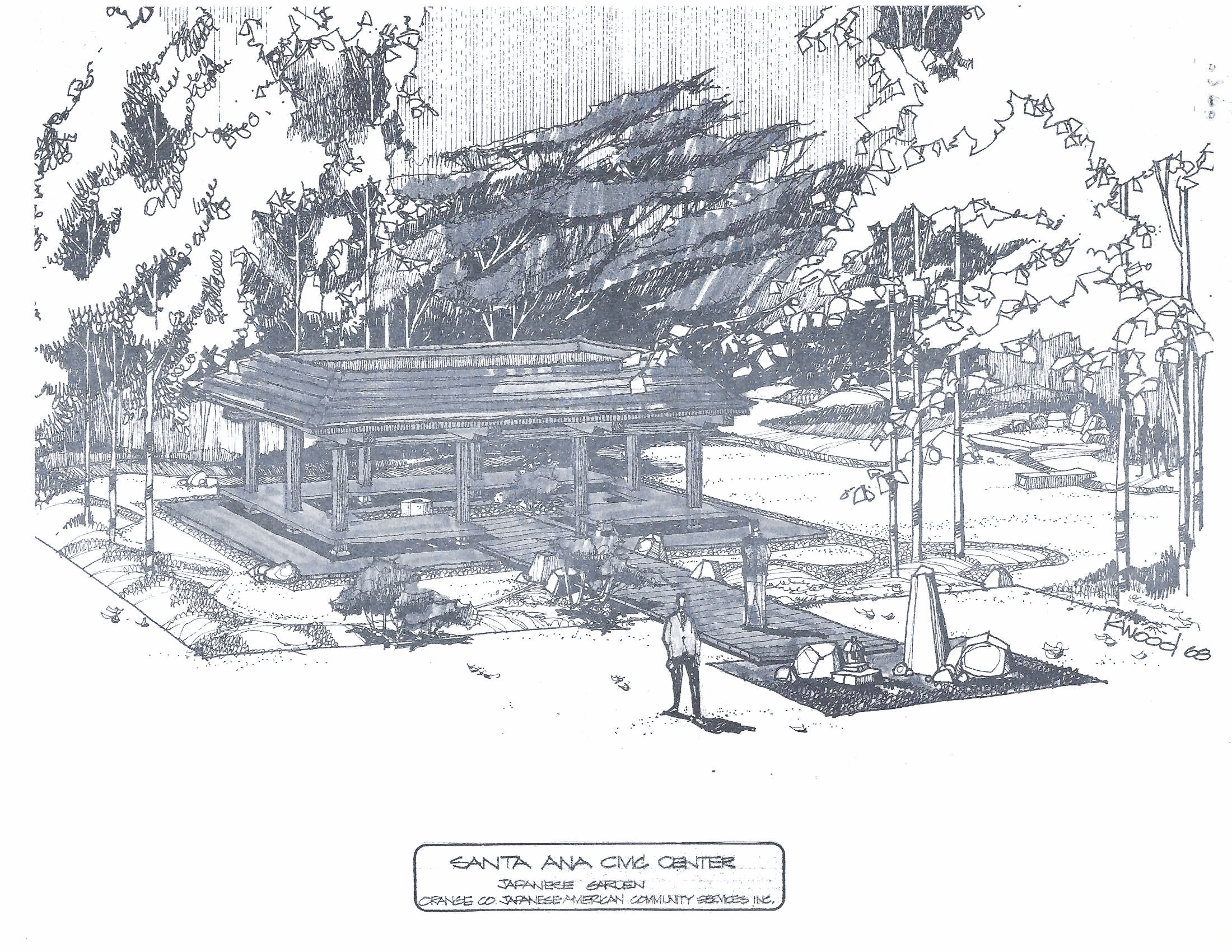
In 1968, Japanese American Community Services had an architectural drawing made for a proposed Japanese garden and tea house in the Orange County Civic Center at 700 W. Civic Center Drive in Santa Ana, Calif. (Photo: Courtesy the Orange County Archives)
I became interested in the history of the Orange County Japanese Garden when I found a donation receipt, an architectural drawing, a location map and a donation thank you letter signed by Japanese American Community Services Board Chairman Hitoshi Nitta and Fundraising Chairman Mas Uyesugi in my family’s records at my parent’s home last year.
I started asking people if anyone knew about the Japanese Garden, yet no one seemed to know of its existence except Ron Inatomi, who had taken pictures at the garden several years before.
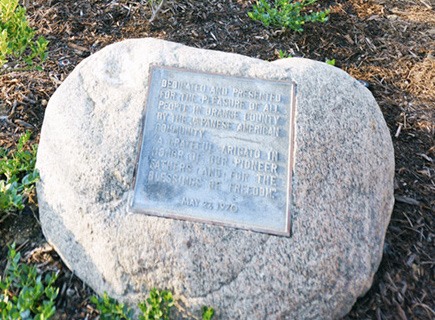
Photo: Patti Hirahara
He sent me a photo of a plaque that was set on a rock in the garden and its brief inscription. The plaque reads: “Dedicated and presented for the pleasure of all people in Orange County by the Japanese American community. A grateful Arigato in honor of our pioneer fathers and for the blessings of freedom. May 27, 1970.”
In seeing this, that meant 2020 would be the garden’s 50th anniversary, but there seemed to be a deeper meaning to the words that were inscribed on that bronze plaque that had become green over time.
This short but meaningful statement was left for us as a reminder of how one community persevered to leave its Japanese American legacy here. But even though I knew a brief history of the establishment of the garden, I wanted to know more on how it all began.
In 1968, the Orange County Board of Supervisors paved the way for a special project to be constructed in the area of the Orange County Courthouse in the City of Santa Ana, Calif., by passing a resolution on Jan. 16, 1968.
This project, to be totally funded by donations, was to be a symbol of friendship and gratitude from the Orange County Japanese American community in the form of a 75-foot-by-102-foot Japanese garden and tea house that would replace a dusty parking lot along the east wall of the new Orange County Courthouse, which was opened in 1969.
According to recent research conducted by Chris Jepsen, a noted Orange County historian, “Plans for the garden were unveiled in June of 1969 by Japanese American Community Services, a nonprofit group chaired by Hitoshi Nitta along with Mas Uyesugi and Paul Nagamatsu, first and second vps; Richard Kasuya, treasurer; and Sumi Akiyama, secretary.
“The plans featured a cedar pavilion or tea house with Japanese roofing tile, a dry stream bed, sculpted earth and traditional plantings,” Jepsen continued. “It was also to feature stone lanterns and other artifacts from Japan.”
The goal of the Orange County Japanese Garden Project was to raise an estimated $50,000 for the cost of creating the garden and tea house, which was quite a sum of money in those days. Therefore, the committee sent out 2,200 letters to Orange County’s Japanese American families in June of 1969 to raise the funds.
A fundraising letter sent by Uyesugi appealed to the community by stating the following points, “We ask you to please search your generous hearts and consider …
“The many opportunities accorded us by our Orange County communities. They have provided us a chance to earn a good living, to live in comfortable homes and enjoy the freedoms.”
The letter continued to say, “We have set our goal high, so we will be able to build not just an average garden, but one to which we can point to with pride. A unique garden which will be a fitting tribute to our Issei pioneers, Nisei’s, Sansei’s and all future generations.”
The plans for the Japanese garden gift were then offered to the Orange County Board of Supervisors on July 1, 1969, and approved.
Fortunately, Jepsen was able to unearth documents that were thought to have been lost. The documents give a glimpse on how these Japanese American pioneers felt about this garden.
In one of the documents, Nitta said, “The Japanese Garden Project is truly a challenge to all Japanese Americans here in this community. This is to be installed in the Orange County Civic Center. Those of us who have become involved in the project have been inspired by the challenge. In the days and weeks ahead, we hope that through a broad cooperative spirit and effort within the entire community, we will be able to put this garden project over the top.”
James Okazaki, who was Orange County JACL president and legal counsel to the project, said, “To borrow an old adage, we submit that there is a time and place for everything, including monuments and memorials. The Japanese Garden proposed for the Orange County Civic Center is such a monument; a living memorial, as it were, to Japanese of all generations who have struggled and strived and have become so much a part of this proud county of ours.”
Okazaki also said, “From all indications, this project must indeed have been meant to be, for this is the commemorative year for the celebration of the centennial of the coming of the first of our parents to our Pacific shores, as well as the 100th birthday of the City of Santa Ana where the garden is to be located. There must be a time within our patterned lives to pause, to reflect, to give thanks, and what better time than this historic year for this community to collectively take stock of our manifold blessings and to dramatically show our beloved county that we are proud to have been part of her heritage.”
Although written 50 years ago, these statements hold so true today. The year 1970 would have commemorated 25 years since the closing of the Japanese American incarceration camps during WWII and the continued resettlement of Japanese Americans to Orange County.
In talking with one of the surviving members of the old Japanese American Community Services Board, Keiko Sadakane, she said, “The group met at the same church the Nitta family returned to in 1945 for their meetings, the First United Methodist Church in Santa Ana, and the Orange County and SELANOCO JACL chapters were part of the project.”
Sadakane was also invaluable in providing background information about the campaign.
Unfortunately, no other records noting who donated to the garden could be found except my family’s copy of an August 1970 issue of the Santana Wind newspaper, which was published by the Orange County JACL.
This gave me a partial list of donors who had donated $38,300 toward the garden’s $50,000 goal. Residents from the City of Anaheim lead the list with 101 donors, followed by Garden Grove with 89 and Santa Ana with 77 rounding out the top three communities who donated toward the garden fund.
In combining the names from the Santana Wind and the Japanese American Community Services’ own promotional solicitation pamphlet, the partial list of donors totaled more than 641 organizations and families throughout Orange County and beyond.
Each Orange County Japanese family was also visited by a member of the volunteer canvassing team to explain the project and why it was such an important endeavor.
The Japanese Garden and tea house broke ground on May 27, 1970, and was dedicated almost six months later on Nov. 15, 1970. The committee said, “You’ll find nothing like this in Japan because this is an expression of Orange County’s Japanese American community.”
“The Japanese in Orange County wanted to present this gift to the county as a permanent landmark for all to view,” Nitta said at the dedication ceremony. “It would also serve as a remembrance for the love of beauty emphasized by our parents and to be carried on by their succeeding generations.”
Nitta died in 1978 at the age of 61. Therefore, I asked his oldest son, Hitoshi A. Nitta, on how his grandfather and father would feel about this garden 50 years later.
“Having family roots connected to Santa Ana for more than 100 years makes the Japanese Garden location there especially meaningful,” Hitoshi A. Nitta said. “Knowing that my grandfather and father were among the community leaders who envisioned this project and brought it to fruition reminds me of what my parents always taught us … to love and respect our Japanese heritage but to never forget that we are Americans.”
Many dignitaries and pioneers of the Orange County Japanese community were present at the dedication ceremony, but now, the majority of those notable pioneers has passed away.
According to Jepsen, “The Los Angeles Times editorialized, ‘Today, when so many think only of what they can get from their government, it is heartening to see one segment of our society stop to count their blessings and then dedicate themselves to a task of unselfish giving. To our Japanese American neighbors, we say, “Arigato — thank you.”
It was the committee’s hope that the Japanese Garden would be utilized by the many people who worked in and visited the Civic Center area.
People have said through the years that county workers enjoyed eating their lunch in the tea house where they could view the Japanese landscaped surroundings, but as of three years ago, the garden had to be fenced off to the public due to the number of homeless individuals that would frequent the area.
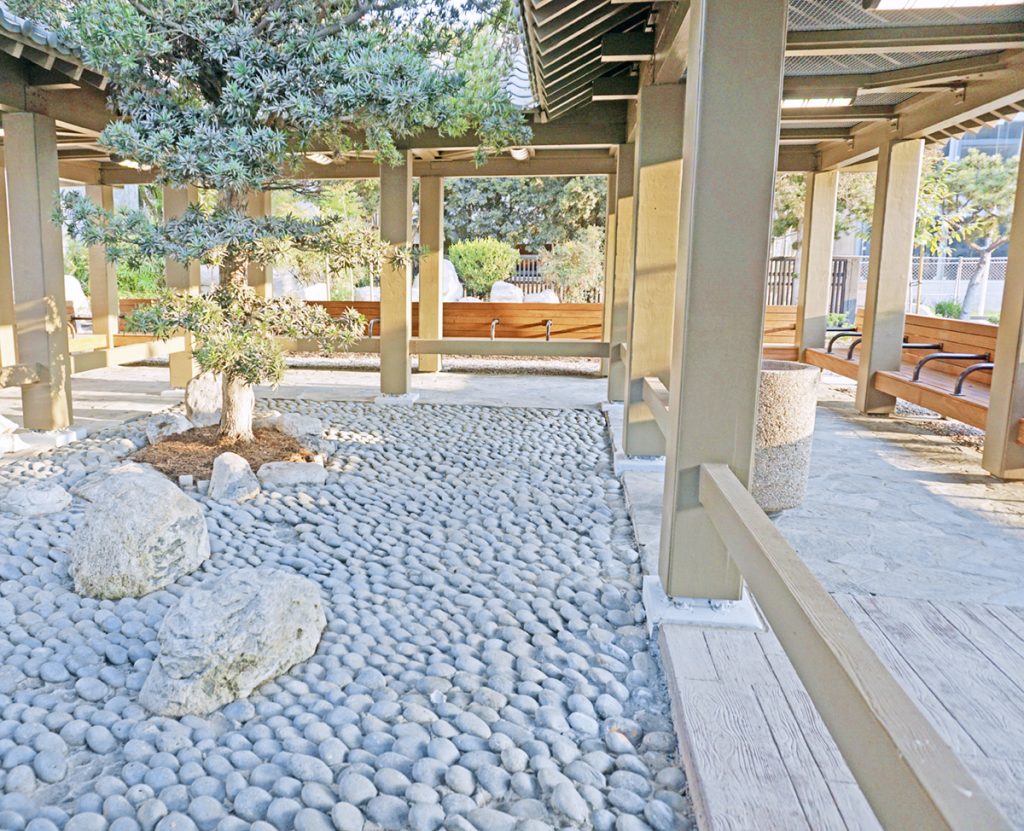
The Orange County Japanese Garden’s tea house is a very tranquil setting within the Orange County Civic Center and a place that should be remembered since it was a gift from Orange County’s Japanese American community to the people of Orange County. (Photo: Patti Hirahara)
However, once Orange County was made aware of the garden’s upcoming 50th anniversary in 2020, Orange County Vice Chairman/Supervisor Andrew Do’s office began preparations to commemorate this milestone anniversary with the Orange County Nikkei Coordinating Council since the original Japanese American Community Services organization was no longer in existence.
“The Japanese Garden in Orange County’s Civic Center is a symbol of unity and patriotism on behalf of the Japanese community,” said Do. “It is an honor and privilege to be part of the Japanese Garden’s 50th anniversary this year. The garden is an expression of the resilience and vibrancy of the Orange County Japanese American community.
“This year, we also commemorate 75 years since the closing of the Japanese American incarceration camps,” Do continued. “As we remember those who were stripped of their civil liberties, let’s never forget the tenacity and resilience of the Japanese American community. In solidarity, Orange County stands with you.”
In addition, Ron Ono, administrative services manager of the City of Santa Ana Parks, Recreation and Community Services Agency/Landscape Architect City of Santa Ana, worked with the Orange County Civic Center Authority (City of Santa Ana and the County of Orange) to receive funding for the Japanese Garden project renovation on Dec. 11, 2019, and have the work implemented in January of this year.
The majority of the renovation was finished in September; finishing touches are being completed now.
At the suggestion of Ono, the Orange County Nikkei Coordinating Council provided a new Japanese stone lantern and a time capsule to preserve significant documents about Orange County’s Japanese Community from the early years to the commemoration of this 50th anniversary.
To be able to have this garden be a symbol of what the Orange County Japanese pioneers had envisioned 50 years ago is an amazing tribute to this community and its $50,000 gift that keeps on giving.
It is hoped that the rededication of this unique garden will remain as a site of inspiration and a remembrance of the beauty of the Japanese culture here in Orange County for future generations.
Being a Yonsei who has lived in Orange County for more than 60 years, I hope the history of this important landmark will now be remembered by all those who live not only in Orange County but throughout this country as a site created by an entire Japanese community who came together to honor their pioneers and a home they held so dear.

